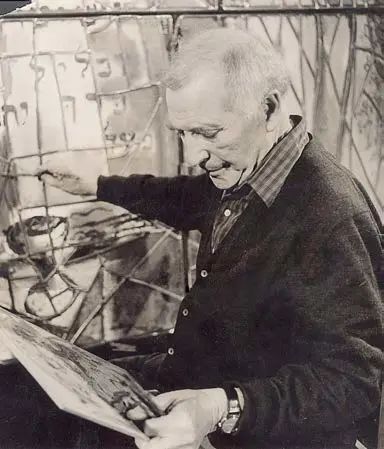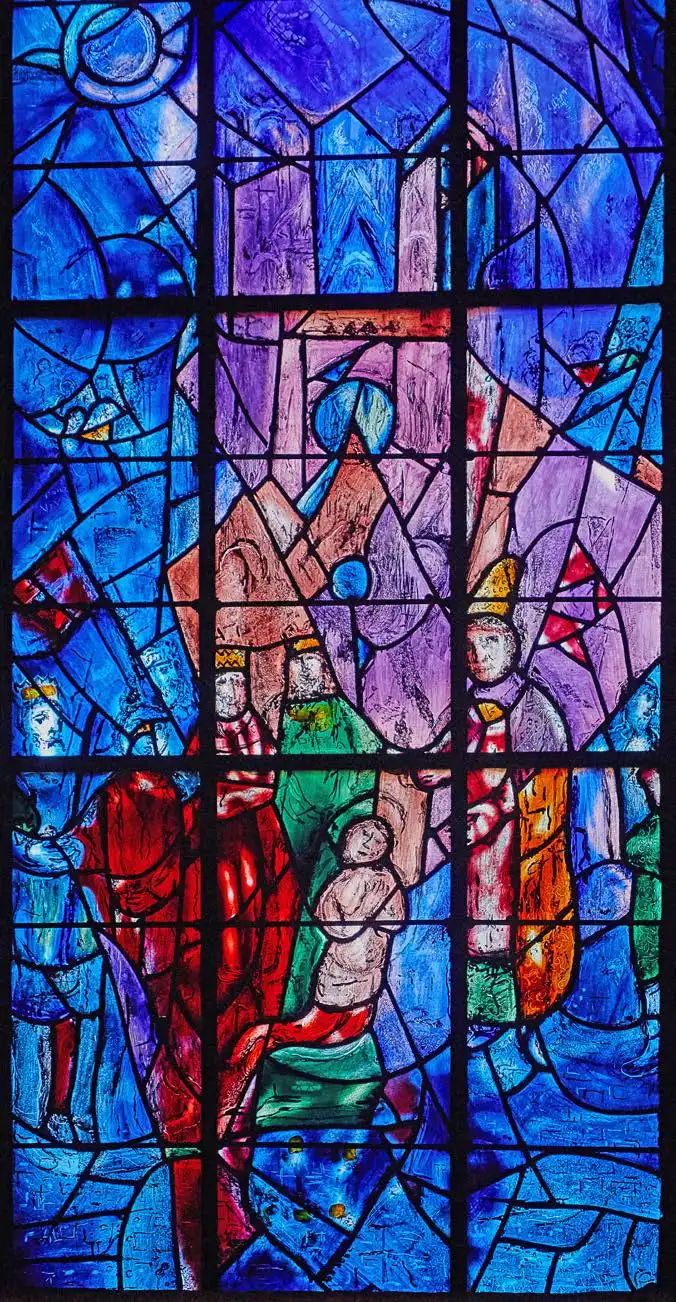马克·夏加尔(Marc Chagall)是一位可以与毕加索和马蒂斯齐名的画家。1887年出生在俄罗斯的犹太人小镇上。他一生坎坷,虽然经过两次世界大战并痛失爱妻,但他从未失去生活的希望。从事绘画艺术50多年来,他致力于探索色彩的大胆应用,声名远扬。尽管如此,他仍想给自己的作品赋予新的形式。70岁的时候,在一座有着700年历史的大教堂里,他看到了一扇画着绿色驴子的彩色玻璃窗,这启发了他用彩色玻璃装饰教堂的灵感。他投身艺术创作,将明亮的色彩和光线注入作品中,直到去世,夏加尔为世界各地的教堂和建筑留下了许多精美绝伦的艺术品。这些彩色窗户神秘、热烈,擅于捕捉光影的变化。让我们走进绘画大师的艺术世界。
Windows That Capture the Sun
Artist Marc Chagall put stained glass in a new light.
By Anna Levine

工作中的马克·夏加尔
At the age of 70, the famous painter Marc Chagall discovered that by designing stained-glass windows, he could breathe bright color and light into his artwork.
“I had to make stained-glass windows. I had to get myself into daylight,” he said.
By the late 1950s, Chagall had already spent more than 50 years exploring the bold use of color. His paintings had made him famous and inspired countless artists. From then until his death in 1985, he created windows for churches, chapels, synagogues, and other buildings around the world.
Today, people still marvel at how his stained-glass creations flicker and change with the sun.
Born in 1887 in a Russian-Jewish town, Chagall started painting at the age of 19. He was frustrated by the neutral colors of traditional Russian art. He loved to paint with strong blues, reds, and yellows. In 1911, he moved to Paris, France. There, actors, writers, musicians, and artists from around the world were creating new art forms.

夏加尔在法国兰斯大教堂(Reims Cathedral)的作品。
Bold Fantasies and Colors
Chagall learned new ways of painting but stayed true to his childhood memories. While others chose modern subjects, he painted scenes of fantasy and fairy tales based on an older, peasant-like way of life. Acrobats and green horses floating above rooftops, yellow skies, and red trees were all creations of his imagination. “My familiar sources remained the same,” he said. “I did not become a Parisian, but now the light came from the outside.”
Chagall lived through turmoil and tragedy. When World War I began in 1914, he happened to be in his hometown. He and his new wife, Bella, were not able to leave for Paris for nine years. Then, in 1941, because they were Jewish, the Chagalls had to leave France to escape persecution by the Nazis during World War II. In 1944 came another devastating blow: Chagall’s beloved Bella died of an infection.

英格兰图德利圣徒教堂(All Saints’ Church in Tudeley)玻璃窗上的天使。
Drawn to Stained Glass
By the 1950s, Chagall’s life was calmer. The war had ended. He had returned to France and remarried. He continued to make his dreamlike paintings and was now world-famous.
One day, during a stroll through the French countryside, he discovered a picturesque chapel. He imagined replacing its walls with stained-glass windows. Some time later, in a 700-year-old cathedral, he saw a stained-glass window that contained a green donkey. It looked as if Chagall might have created it himself. Here was a sure sign, he thought, that he should create his own stained-glass windows.
He began collaborating with master glassworker Charles Marq. Many stained-glass windows are made of flat colors, but Chagall used various techniques to create the effects he wanted. He painted images on glass, then had them fired to high temperatures, making the lines and colors part of the glass. “Stained glass is not so easy,” he once said. “You have to approach it as if you were trying to catch a mouse. Not in a cage . . . but with your hand. There are no foolproof methods, you either catch it or you don’t.”
Marq admired Chagall’s energy. He said Chagall worked “with the precision of those tightrope walkers he loves, who fly in their weightlessness up there thanks to an immense amount of everyday work.”
When Chagall was asked to design stained-glass windows for a synagogue in Jerusalem, Israel, he faced a new challenge. The Jewish religion forbids the drawing of human figures. Since Chagall was not allowed to include images of people in the windows, what could he do instead?

以色列耶路撒冷哈达萨大学犹太教堂(Abbell Synagogue)的十二扇玻璃窗之一。
Bible Stories in Glass
He told the story of the 12 tribes of Israel with animals. He drew the animals described in the Bible stories to represent each of the tribes. He then chose a vibrant color for each window. When the sunlight shines through the glass, it sparkles as if made of rubies, diamonds, and emeralds.
At the same time, Chagall was creating huge stained-glass windows for the Roman Catholic Metz Cathedral in France. These works tell the stories of biblical heroes. Chagall’s Jacob wrestling an angel flickers and glistens with life in the sun.
In 1964, Chagall designed a stained-glass window for the United Nations building in New York City. The United Nations works for international peace. Using a blue background as the symbol of peace and life, Chagall designed the window with an angel soaring from a bouquet of flowers, animals floating in the sky, and mothers cuddling their children.
Chagall had lived through two world wars and personal tragedy, but he still had hope for the future. He often refused payment for his stained-glass windows, especially those he made for places of worship. He created them as gifts for the world, gifts that capture the sun.

本文刊登在《英语沙龙》(原版阅读)2022年10月刊
责任编辑:Zan
| 留言与评论(共有 0 条评论) “” |